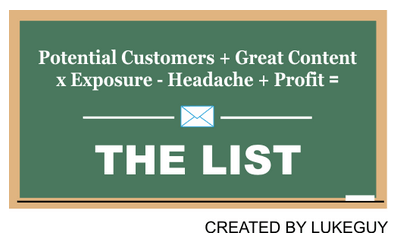
 As a marketer, entrepreneur, or business owner, you’re always looking for a way to keep the fire going between you and your customer. To keep the connection alive.
As a marketer, entrepreneur, or business owner, you’re always looking for a way to keep the fire going between you and your customer. To keep the connection alive.
You’re also looking for ways to build connections with new customers, for ways to stay in front of both new/old/potential customers.
What if I told you that you can do all this at the same time?
Well, you can. It’s all about building and maximizing your email list.
It was the beginning strategy behind Facebook actually, to do all 3 things at once. That’s why it did so well at first for businesses. You could accomplish all of the above by posting a status in a creative manner.
It was harder to get “likes” than emails, but hey, it was hip and effective.
Now it’s 2014, and you’re lucky if 5-10% of your Facebook fan base even see your next Facebook post (unless you pay for it).
The average email, on the other hand, is seen by 20-30%. That’s 3 times the exposure than of Facebook. Your click rates will always be higher than Facebook. So email wins once again.
But you know this already, so let me explain how to do the first 3 objectives while making money at the same time.
How to Develop an Email Strategy That Generates Revenue
If you already have a customer base:
- Ask your customers if they’d like to be on your list of exclusive content that would normally cost money. Be honest about the value. Tell them that you want to add value to their life for simply being a great customer.
- Keep track of the emails with an email marketing tool like Mailchimp, Aweber, or Infusionsoft. Keep track of who’s opening your emails the most and clicking the links.
- Send that list true value with helpful information from your experiences or your blog that is relevant to them.
- Research to improve that email experience and give greater value by producing eBooks, webinars, checklists, videos, etc.
- Ask questions in your email. The ultimate goal is to get responses and to see how you can improve both the services and products you provide to your customers.
- After you conduct your research, offer a solution through your content and resources. Since all of this is related to your niche, you will show your audience that you are an authority. They will share your content so that new potential customers are seeing your content, exposing them to your brand and your products. Simply ask and deliver over and over again. It’s how you’ll produce traffic and gain exposure. Those new people will want to be on your list too, so they can receive this information.
- Here’s where the money comes in: You can take all the content that you created for this list (the eBooks, webinars, checklist, videos), and combine it in a course or bundle to sell to a newer list down the road. Be careful about trying to sell more stuff to current customers. Instead, I would recommend trying this on potential customers.
The key is to stay on topic and within your niche.
All this can be done free, and you’ll become a thought leader along the way. You’ll gain new exposure from potential audiences you may have not been able to reach before, plus you’ll produce revenue by selling the resources you spent time creating for your list.
What kind of email should I send?
Send your subscribers a message along with an article that will improve their life. You know what their problems are, and it’s your responsibility to offer solutions to those problems.
Write to them in a personal way and make sure your branding is consistent throughout. Check out these examples of great emails if you’re unsure of how to format your email.
How often should I send email?
Depending on what you do, it varies. Average emails go out two to four times a month.
Ask your list to find out what they want. Start with once a month (if you’re unsure) and go up from there to monitor the results.
Another purpose of these emails is to keep your brand at the top of their mind, so consider that goal as you decide how often you want to send your emails. Because our email world is so saturated, only the best content will keep you in front. If you make their life easier, simpler, and richer, you must offer useful content without annoying them.
What’s the best provider for mass-email?
Mailchimp is a free up to 2,000 emails. It’s probably the best provider for businesses who are just starting out.
If you want to step up your game, use a more robust tool like Aweber or Infusionsoft. These give you more control of your content and form designs. I personally like Mailchimp and have stuck with them. Michael Hyatt feels the same about Mailchimp and he has over 400k emails on his list. Convince & Convert has even switched to Mailchimp this past year.
It’s really up to you. The main thing is to keep your open rates high as possible and your unsubscribe rates as low as possible.
What’s the goal of building this list?
The first goal is to maintain your trust with the customer. You do this by helping them and offering super valuable content. Combine this with entertainment, personality, and BAM! You just turned your customer into a raving fan.
This list is also great research tool to examine who your customers are and what they’re struggling with.
The final goal is to offer solutions to their problems and therefore, keep your customers for life.

